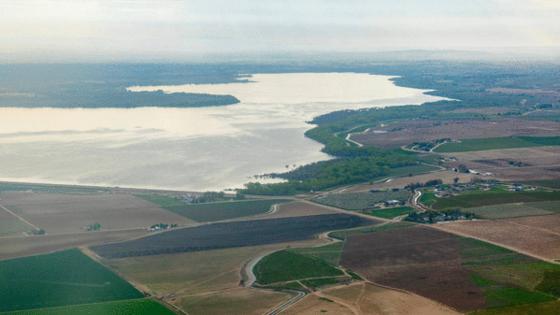Walleye invade a Boise-area lake. What it could mean for SW Idaho waters.
Published in Outdoors
BOISE, Idaho — Idaho Fish and Game is asking anglers to “catch, kill and keep” a nonnative fish that threatens the populations of other fish species at a popular reservoir in Canyon County.
The guidance comes as Fish and Game officials say a walleye population has “established” itself after illegal introduction to Lake Lowell in Nampa, posing a risk to native and sport fish in the region.
“They’re in there and they’re reproducing,” said Art Butts, a fish biologist who manages Fish and Game’s Southwest Idaho fisheries.
Butts said the department has been fielding daily calls from anglers reporting catching walleye in Lake Lowell, which is part of the Deer Flat National Wildlife Refuge. A few years ago, he said, those reports, mandated by Fish and Game, were much rarer and helped the department track where the species was cropping up and whether they were reproducing.
Now, walleye in Lake Lowell have “a self-sustaining population,” and the message to anglers is shifting: “If you catch one, keep it,” not release it, Butts said. “Kill it, keep it, and, you know, eat it if you want to.”
Walleye not ‘a good match’ for Southwest Idaho
Butts said the walleye population has “advanced quickly” since the fish was first reported in Lake Lowell in 2022, likely after illegal introduction by an angler. The fish, native to parts of Canada and the Midwest, can be harmful to other fish populations in Idaho, he said.
“Idaho and walleye just aren’t a good match in most places,” said a news release from the department announcing the guidance.
The large lakes where walleye come from typically have “prolific forage bases of minnows, shiners, chubs and other small baitfish,” the release said. “Those baitfish are not available in most Idaho waters, so walleye are likely to eat other game fish that are highly valued by Idaho anglers.”
Walleye could feed on native nongame fish like redside shiners, plus crawfish, which are freshwater crustaceans, in Lake Lowell and other waters, Butts said. But his biggest concern is that they would “be competing and taking food from large-mouth bass” — particularly because Lowell is one of the top large-mouth bass fisheries in the state.
He said he’s seen years where water levels are lower than usual and there are fewer forage fish, and large-mouth bass have been skinnier as a result. Reservoir levels peak in early spring with water diverted from the Boise River by the New York Canal. The levels fall through the summer as irrigation canals carry the reservoir water to Canyon County farms.
“Just because there’s places in the Midwest that do really good with walleye, and they haven’t impacted large-mouth bass ... that doesn’t mean that they’re not going to have an impact here,” Butts said.
Other management strategies could cost millions
Butts said managing walleye populations is challenging in part because of costs.
“We know that angling by itself is probably not going to do much for the population,” he said, though he still hoped that anglers eager to fish for walleye could play a role in management. “Walleye are considered one of the best-eating fish in freshwater, and so while we’ve got this problem, let’s get the word out to folks that might interested in fishing for them,” he said. “Here’s a place where you ... have a good opportunity to do that.”
More comprehensive solutions would be too costly, Butts said, in terms of money and staff time. Those could include treating the lake with rotenone, a fish pesticide that works by blocking a fish’s ability to process oxygen. But treating a lake of Lowell’s size would cost “several million dollars,” Butts said. It would also “kill everything,” he said, not just walleye.
“Rotenone doesn’t discriminate between desirable and undesirable fish species,” said a 2011 Fish and Game news release about another unwanted fish in Lake Lowell, common carp. “If Lake Lowell were treated, it would take several years and intensive stocking to rebuild fishable game-fish populations.”
Another option would be for Fish and Game to set nets along the lake to catch as many walleye as possible, but Butts said that because of the size of the lake, that “would require so much labor, so much effort — we just don’t have the kinds of funds to deal with that.”
“The only tool we really have at this point is anglers,” he said.
Risks to Snake River, other waters
Fish and Game stocks walleye in three reservoirs in the state: Oneida Narrows, Salmon Falls Creek, and Oakley. He said that’s because those reservoirs have more “isolated” water systems where management is easier.
But they’re also a long way from Boise. For Butts, that’s a double-edged sword. On one hand, anglers in the Treasure Valley who don’t usually get to catch walleye now have an opportunity in Lake Lowell to fish and to help with population control. On the other, having walleye in Lowell means a greater risk of spread to other waters in Southwest Idaho, either naturally down the Snake River or by illegal introduction.
“There’s a subset of anglers,” Butts said, who want more opportunities to fish for walleye and might disagree with Fish and Game departments in Idaho and other western states’ approach to managing walleye. Some “bad apples,” he said, “take it upon themselves to go ahead and stock them, because they don’t like the answer no.”
Butts was firm that “there’s a lot of documentation for the problems that walleye have created” for other fish species. “They’ve crashed a lot of traditional sport fisheries,” like Washington’s Moses Lake, where walleye introduction hurt crappie fishing, Butts said.
“It’s not that we’re totally against walleye,” he said. “A lot of us like fishing for walleye, but we recognize that these fish have a limited place where they can fit in Idaho.”
Butts said walleye reports are rising in the Snake River below Swan Falls Reservoir, suggesting walleye may soon become established in the river as well. He is concerned about them spreading further downriver to Brownlee Reservoir, where fishing for bluegill, perch, catfish and other species is popular; or going up the Payette River or the lower Boise River near Caldwell and Parma. In the Snake River, Butts worries that walleye would be “adding another predator” to already declining populations of redside shiners, chiselmouth and other native nongame fish.
Preventing that spread through barriers or screens would be too costly to install or maintain in Lake Lowell and not necessarily effective, Butts said.
If the spread continues, he said, the department may eventually instruct anglers to “catch, kill and keep” walleye in additional areas. But for now, anglers are still instructed to report walleye catches outside of Lake Lowell and to provide carcasses to Fish and Game. The department analyzes the bone structure on those samples to determine how long walleye have been in a certain area, whether they have reproduced and, if they collect enough samples, possibly even where the fish came from.
Carp, cyanobacteria: What to know
Fish and Game is up against another threat in Lake Lowell: carp, which have been seen in the lake since at least the 1950s. Neither common carp nor walleye are deemed invasive in Idaho, but both are nonnative and can harm waterways, Butts said.
Butts said Lowell Lake’s carp population — nearly 1.3 million as of a 2010 study — has damaged the lake’s water quality and has been an ongoing concern for lake-goers. But he dismissed the idea that walleye could help reduce carp populations.
“The problem is that carp grow so quickly in their first year, and they’re such a wide fish,” he said. “Carp can outgrow being eaten by most walleye within four or five months, and by about eight or 10 months, there’s not really a fish big enough in Lake Lowell that could eat one of those carp.”
Despite carp and water quality concerns, fish caught in Lake Lowell can be eaten in accordance with the recommendations by the Department of Health and Welfare’s fish consumption advisory.
Butts also pointed to the Department of Environmental Quality, which monitors harmful cyanobacteria blooms in Idaho and has guidance on eating fish from a water when there is a bloom. There is no active bloom in Lake Lowell now.
©2025 The Idaho Statesman. Visit idahostatesman.com. Distributed by Tribune Content Agency, LLC.







Comments